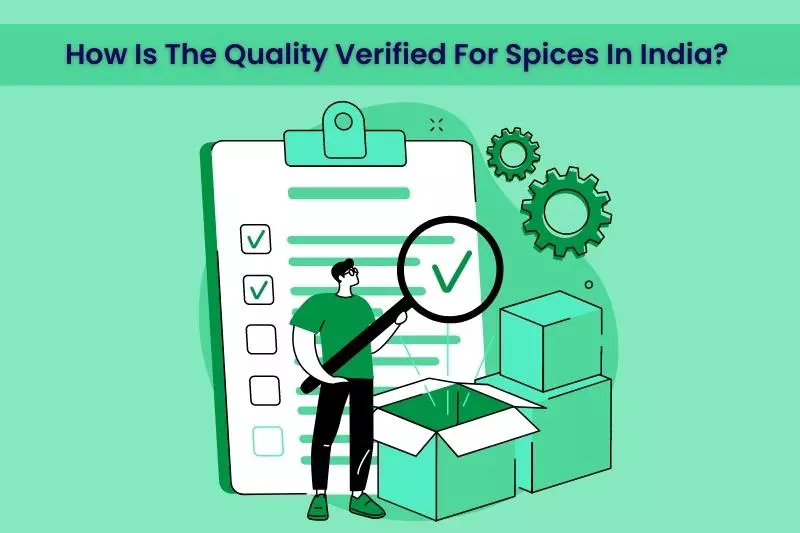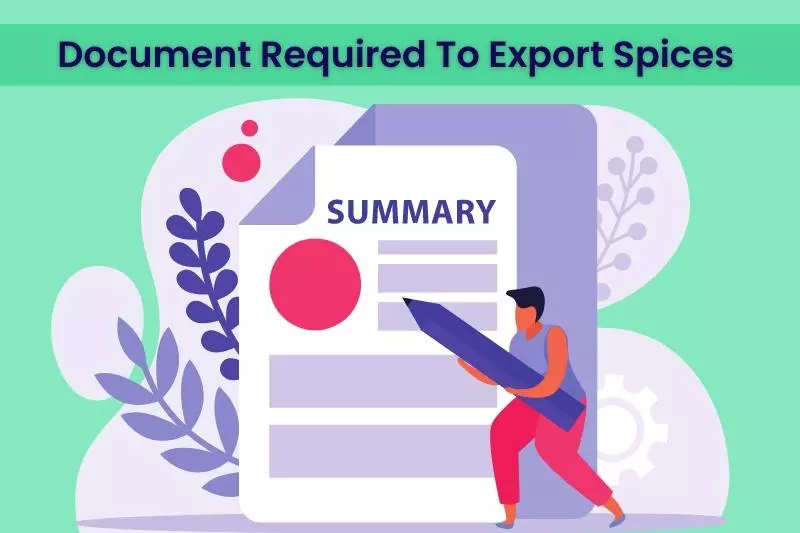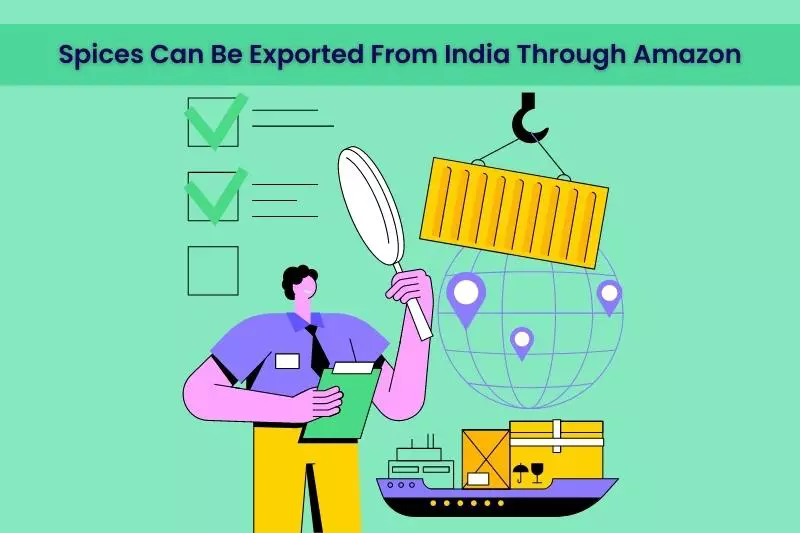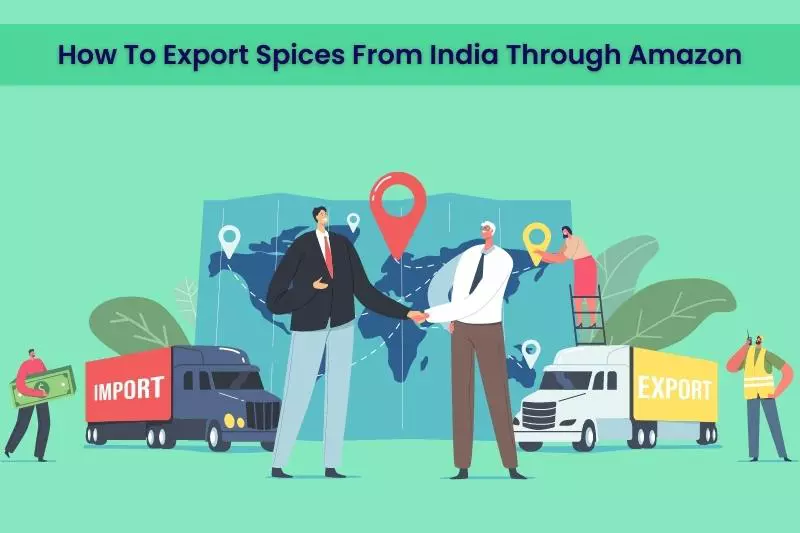How To Sell Spices On Amazon (Step by Step Beginner Guide)


Maximize Festive Season Sales With Fynd Platform
Learn from the masters and cracks the code to festive season sales success with Fynd Platform's Festive Readiness Guide
.webp)
Spices and condiments are in high demand all over the world. Without the basic spices, any kind of cuisine remains incomplete. Moreover, herbs and spices have many medicinal benefits as well. Especially in India, homemade herbal remedies for minor ailments are often brewed with different spices.
Needless to say, the demand for spices is constant, making it a highly profitable business. So much so that online business for spices is booming in India largely. Today, the Indian spice market is expected to reach INR 270,928 by 2027.
The CAGR will be 11.15% from 2021-27. If you are planning to tap into this market, especially online, Amazon is a great place to start. It is a great platform to set up your online spice business with minimum investment. Eventually, you can expand to an independent website too.
Fynd platform is a great option for setting up the individual website. You can design the website in minute to minutes and make the most of the platform’s traffic to boost your business. What more, you can grow the business exponentially by driving sales on Amazon through the website too.

Why Sell Spices Through Amazon?

When we think of spices, local shopkeepers and retail stores are the main sources that we think about. But as the world is getting digital by the day, demand for spices through online platforms grows as well. But when you have a steady offline spice business, why tap into the online world? Here are a few perks to explore:
1. Get global
There is a world-wide demand for Indian spices. Think big for your business. With online stores, you can easily get customers from any part of the world. Especially through a platform like Amazon, getting more exposure from potential clients gets easier.
Online stores also let you explore various payment options and modes of selling which in turn gives more flexibility to purchase for your clients. This also helps you gain diverse clients and conduct sales smoothly.
2. Cost-effective
Setting up a spice retail store is costly. Location, store rent, electricity, aesthetics, storage cans and other important elements altogether cost a hefty amount. But when you have an online store exclusively, you can cut down the costs to a large extent.
A lot of money gets saved when you do not need a store-front, electricity or maintenance cost for the place. Moreover, setting up a store on Amazon does not require much investment which also makes the process much easier.
3. More exposure
There are many flourishing brands of spices in the different states in India. Also, there is a high demand for localized spices as the society gets more multicultural. For example, unique spices of south India are now in demand in the northern states as more people settle interstate for their career. Thus, as a spice seller, you can make the most of these platforms to meet these demands all over the country.
4. Higher profits
Since your cost of setting up a store gets significantly reduced and in parallel you get more exposure from potential clients, the profits are much higher. This is another reason to set up the online store. Growing your business exponentially is made possible when you have innovative selling methods.
How To Get Seller Approval In The Food And Gourmet Segment On Amazon?

Spices are traded in numerous domestic and international marketplaces and are categorized as commodities. Online shopping is the new trend that has hit the customers, especially after the COVID-19 pandemic, and Amazon has become the new synonym for online shopping, especially in India. From luxury products to daily essentials, Amazon has become the new store for shopaholics.
It is one of the leading online marketplaces and enjoys a footfall of millions of customers every month. This online marketplace is a golden opportunity for the seller as it exposes the product to a more extensive customer base and allows the product to cross geopolitical borders. Amazon is a platform that is being utilized by all types of businesses, irrespective of the size of the business.
Spices are one category that falls under the food and gourmet segment that is being widely traded on this platform. Customers extensively purchase spices through Amazon, and the seller can definitely gain huge profit if they list their product on Amazon. However, Amazon has defined a few sets of standards that the seller must possess to sell spices on the platform.
Why Is Amazon keen On Getting Approvals For Spices?

Amazon believes that customer safety is of extreme importance that can enhance the confidence of customers to purchase from the site. This is the primary reason for setting up many rules and regulations by Amazon to ensure a safe and compliant product reaches the end customer. Amazon asks for various documents and performance checks to ensure compliance.
The products categorized under food and gourmet require approval. Amazon takes more than two weeks to provide approval despite submitting all the required documents. Spices are tricky products, and it takes an ample amount of work to convince the customer of the quality of the spices.
This is the reason Amazon implements many regulations on the spices that are listed on the platform. The appearance can be deceiving when it comes to spices, and additional documents and licenses are required to showcase the authenticity and quality of the product to the consumer.
Amazon’s Core Principles:
The primary step toward trading on Amazon is to have a seller account on Amazon. The seller must have a legal name, business name, address, and ID proof to start an account. The bank account details must be shared along with Tax Identity Information.
Amazon focuses on three factors when it comes to spices:
1. Product Quality:
Amazon does not accept poor quality products; in fact, poor reviews of the product may even delist the product from the site. Spices possess an expiration date and a certain shelf life. The seller must enlist the product on Amazon with a shelf life greater than three months. Amazon FBA program allows one to sell products with expiration dates, but they remove the product within fifty days of expiry.
There is no refund or return of the product in this case. The spices must be able to withstand a temperature of 50 to 100 degrees Fahrenheit (37.78 °C). Amazon allows meltable spices only during a specific time of the year, i.e. from October to April. In case the product requires cold chain maintenance such provision must be undertaken.
2. Product Branding:
Amazon asks for a set of pictures of the product and its packaging, showcasing the product from every angle. It also makes the text on the product or labels mandatory to be visible to the customer. It ensures that the calorie value of the spice is clearly visible to the consumer.
Amazon doesn’t accept mock labels or computer-generated images. The product must be properly packed and sealed as moisture can spoil the product. The product packaging must list the manufacturer’s universal product code and be written in English.
It must be compliant with the necessary laws. Amazon is very strict on the labelling requirements with respect to spices. Amazon doesn’t accept stickers or anything that is easily removable for important information like calorie value or nutrition facts. The product image must be of high quality and of a minimum 1000-pixel size.
The packing must be able to resist spoiling, melting, damage and exposure to external environmental conditions. Spices get contaminated if water seeps into the packaging and may also get infested with microorganisms.
3.Product Safety:
Amazon makes it mandatory to have an FSSAI licence and Food declaration when it comes to spices. Food Safety & Standards Authority of India registration is mandatory compliance that ensures the food products manufactured and supplied are safe.
It is issued by the respective food authority of India. It is compulsory for the seller to display the FSSAI license on the Amazon platform. Under FSSAI, there are three kinds of licenses-Central and State FSSAI License and Registration.
The seller must also possess VAT and CST certificates. BIS License is another certification that is desirable certification on Amazon. BIS certification guarantees the quality, safety and reliability of products to the customer.
The Indian Government has made BIS certification compulsory for certain products, considering public health and safety. GST registration is another mandate if someone plans to sell spices through Amazon.
A professional selling plan along with valid invoices are needed to sell products on Amazon. If one is already a seller on Amazon, they must have an order defect rate of less than 1%, a pre-fulfilment cancellation rate of less than 2.5 % and a delayed shipment rate of less than 4%.
Documentation Requirements:

Business documentation is equally important as product documentation if one plans to sell their products on Amazon. The invoices, purchase orders etc., are a few documents that are mandatory for Amazon.
Amazon makes it very strict and accepts invoices with at least 30 units and dated within 90 days. It should clearly mention the document issuer’s name, phone number, email, website and address, contact information and business name.
If the seller doesn’t have an invoice, they can produce an FDA Certification registration document or New Dietary Ingredient notification document. Amazon usually rejects retail receipts, packing slips, sales orders, online retailer invoices etc.
Best Practices to follow:
a) Familiarize with the terms and conditions:
It is highly recommended to thoroughly understand the temperature and shipment requirements by visiting the official website before launching the product on Amazon.
b) Know your Nation’s Rules:
Amazon is a platform that allows one to sell the product in many countries. Hence, one must be thorough with the country’s official guidelines. The few governing bodies one must be aware of when trading spices are as follows:
1. FDA (Food and Drug Administration) determines the meat and vegetable content and works with the United States Department of Agriculture (USDA)
2. FSSAI is the Indian authority for setting food safety standards to ensure healthy food practices.
3. EFSA (European Food Safety Authority) is Europe’s answer to the FSSAI and is not lumped in with medicine management.
The ultimate pro-tip in the case of spices is to avoid providing false dietary claims. One must do in-depth research before putting something big on the product description.

c) Begin with Small targets:
It is advisable to start with a small quantity when it comes to spices. If one plans for a private label, they must abide by many regulations, especially the local laws. Amazon is an international brand; enlisting the product on such a huge platform will fetch good profits for the seller. Hence, one should try to abide by the set rules and regulations to expand their business.
How Is The Quality Verified For Spices In India?

Food is a boring component without spices as they impart the desired colour, flavour and aroma to the food. Apart from adding texture and flavour to the food, spices also fulfil purposes like preservation, medicinal benefits, nutrition, etc.
Due to their antimicrobial properties, spices have found various benefits and applications, along with enhancing myriad aspects of food products. Spices are also listed as commodities and are traded in multiple national and international markets.
India is identified as the home to spices and houses a lot of spices in various nooks and corners. Kerala, the land of spices, is an integral part of India. It is believed that the foreign colonies got attracted to India because of its high-quality signature spices.
Spices are one of those products where quality has the upper hand over quantity. If the quality is up to the mark, then a small quantity will even fetch the desired results.
There are multiple factors that exert a role on the quality of the product like packaging, changes in the weather etc. Hence, it is necessary to get the spice tested at every stage to ensure they are safe to be consumed.
1. Quality Assurance:
Quality assurance starts from the procurement stage and should be maintained till the packaging stage. The quality check is undertaken at every stage of the supply chain.
The quality assurance is maintained through four main stages:
1. Manage the cultivation and harvesting practices
2.Spice quality must be inspected during procurement
3.Monitor the processing methods used in the manufacturing unit
4.Spice testing must be done appropriately during packaging and storing
The dried products are comparatively at lower risk due to less moisture, but spices encounter different risks. At first, the sample is physically examined for foreign matter like dirt, dust, stalks, stems, and extraneous matter and is subsequently removed with the help of sieves and other aids.
Other physical parameters examined at this stage are the product's colour, flavour and general appearance. Further, the samples are subjected to appropriate tests like volatile oil, moisture, ash, insoluble acid ash, etc. and other tests specific to the material.
The samples may be microbiologically tested for the presence of Salmonella and E. Coli, and the product is considered acceptable if found to conform to the standard levels. The inappropriate material is rejected or reprocessed depending on the extent of the contamination.
Various statistical methods are employed in ensuring that quality requirements are met, like Pareto analysis, control chart etc. The finished product is finally subjected to sensory tests.
2. Importance of Spice Quality Testing:
As spices are added to everyday food, they must meet the necessary quality parameters. Spice testing ensures that individuals do not face health hazards in the form of any contaminants or impurities. The spice quality testing is vital due to the following:
1.Maintain benchmark standard in the domain of spices
2.Ensure the end customer consumes a safe and nutritious product
3.Attain a competitive edge in business
4.Establish a position in the market
5.Scope for continuous improvement and retaining customers
6.Maintain quality
Testing spices at every stage is crucial to maintain good quality and ensure the end customer gets the safe product for consumption. The best quality will expand the businesses worldwide as spices possess a great demand in the market. Various methods and processes are utilized to evaluate and analyse the quality and safety of spices in India. A good quality spice must meet the national and international standards.
3. Botanical Evaluation
A macroscopic analysis is the first step undertaken as part of the evaluation and testing process. The presence of extraneous substances is detected through this method. The presence of hairs, insects, feathers etc., is seen in this process.
The next step is microscopic analysis, where microanalytical techniques are used to understand the condition of the product when they are produced. This is the primary step to analyse the quality of the spices, which helps to categorize the product into poor quality or good quality categories.
4. Microbiological Evaluation
The next step to the microscopic analysis is microbiological testing, where the product is tested for the presence of pathogens and microorganisms. In this stage, the product is evaluated for the presence of yeast, mould, E-coli, Salmonella etc. The absence or presence of these substances indicates the cleanliness level of the product at a microbiological level.
5. Organoleptic Analysis
The next stage is testing the product for its appearance, colour, aroma and flavour. This testing helps to understand the characteristics of the spice. In this stage, various spices undergo various methods to get tested for multiple parameters. For example, to test turmeric's colour, it is advised to mix a teaspoon of turmeric powder in hot water.
If the spice is pure, then the turmeric will settle down to the bottom without changing the colour. In case the water becomes cloudy, then the chances of adulteration are there. There are multiple regulations implied on colour control as a method to ensure high quality. The American Spice Trade Association (ASTA) has compiled a list of standardizations for using colour control methods.
Multiple agencies like the FDA and USDA inspect the quality of the product by various inspections and grant licenses after testing the quality of the product. The ASTA has even suggested a few recommendations for detecting the pathogens in the spices:
1. Minimizing the risk of introduction of filth
2. Prevent contamination during processing and storage
3. Use only validated microbial reduction techniques
4. Perform mandatory post-treatment testing
5. Ensure to have a clean manufacturing environment.
Spectrophotometers are used to measure the colour control in spices.
6. Chemical Analysis
The spices also have to undergo chemical residue testing to test for the presence of harmful pesticides like solvent residues or ethylene oxide residues. This process also tests for the presence of toxins like Aflatoxin and Ochratoxin in the spices.
This method also looks for the presence of heavy metals like Lead, cadmium, Arsenic, Mercury, methyl mercury, Copper, and Tin in the spices. Chemical analysis also measures the amount of moisture, water-insoluble steam volatile oil, carbon-free ash and acid insoluble ash in the spice through various methods.
7. Physical Analysis
The particle size is an essential criterion in determining the quality of the product. The spices undergo physical testing to determine the particle size. This testing also measures the amount of foreign organic and inorganic matter in the product. This method also measures the spice density, which further supports the decision of storage and packing.
Few other tests:
1. Piperine levels:
The test is done explicitly for peppers. In this test, the extraction measurement of the characteristic heat portion of pepper is done. The piperine extract is refluxed, and its absorbency is compared to that of a standard in the spectrophotometer.
2. (ASTA) Colour values:
This test is used to estimate the extractable colour of the products from capsicum species. This test indicates the quality of paprika.
3. Capsaicin content:
The heat in the capsicum species is characterized by the pungent component of Capsaicin. Capsaicin is extracted using alcohol. The estimation is done using HPLC
4. Scoville heat units:
It is the estimation of heat levels that is capsaicin content in the capsicum species. In this test, the capsaicin is extracted in alcohol and its successively stronger dilutions in sugar syrup are tasted until the chilli heat is detected.
5. Curcumin content:
This test estimates the extractive colour of turmeric. The colour is extracted in acetone, and the measurement is done with a spectrophotometer.
Spice Board Of India:
The Spice Board India is an initiative under the Ministry of Commerce & Industry, Government of India and is the leading organization to promote the export of Indian Spices.
The Board formulates and implements the quality improvement systems, research and development programme, education and training of farmers, processors, packers and exporters on post-harvest handling and registration and licensing of traders and exporters. It promotes Indian spices abroad and is also associated with international organizations.
Document Required To Export Spices

India is entitled as the spice bowl of the world because of the enormous varieties of spices grown in different corners of the country. Spices perform various functions apart from lending texture and flavour to the food. They are also used as products that add medicinal value to the food and are traded in numerous domestic and international marketplaces.
India is acclaimed as one of the leading exporters of spices to various countries. Indian spices like pepper, turmeric, mint, ginger, curry leaves etc., possess huge demand worldwide. This massive appetite for spices from different parts of the world motivates business minds to enter the spice export business.
Benefits of exporting spices from India:
There are multiple benefits associated with the export of spices to various nations, which are listed below: Eligible for various subsidies: A business owner involved in exporting spices is eligible for multiple subsidies and can ship the samples at a lower price.
Huge demand:
Indian spices carry medicinal properties and are used to deal with ailments like obesity, nutritional disorders, digestive issues and other chronic conditions. Hence, spices are used for culinary purposes and widely shipped for medical purposes. This huge demand for the product will keep the business viable and profitable.
Indian spices have tremendous credibility within the international market, thus ensuring a remarkable demand in the future. The exporters also get subsidies for creating promotional videos, clips, or other marketing campaigns. The spice industry is a sustainable and economical option.

Documents required to start a Spice Exporting Business in India:
The sellers must adhere to certain compliances to export spices to the international consumer. They are bound to have few registrations and licenses to start trading spices.Registration under the Ministry of Corporate Affairs: The business must be registered with the Ministry of Corporate Affairs with the name of the business, details about the partner and address proof.
Food Safety & Standards Authority of India registration is mandatory compliance that ensures the food products manufactured and supplied are safe. It is issued by the respective food authority of India. It is compulsory for the seller to display the FSSAI license.
Under FSSAI, there are three kinds of licenses- Central and State FSSAI License and Registration. BIS License is another desirable certification to run an export business in spices. BIS certification guarantees the quality, safety and reliability of products to the customer.
The Indian Government has made BIS certification compulsory for certain products, considering public health and safety. GST Registration is another mandatory license for businesses who want to export spices from India. To export anything from India, the seller must attain an Import Export Code, a ten-digit code given by DGFT to trade across borders legally.
Certificate of Registration and membership as Export Spices from the Spice Board of India is another legal document for exporting spices. To obtain this certificate, one should produce an IEC certificate, a demand draft of INR 5000 in favour of the board, a GST registration certificate and a PAN card.
Apart from these, MSME registration, Goods and service tax, authorized dealer code, Bank account, passport-sized photograph and PAN card are the other required documents for the business.
Different Spices You Can Export From India

Due to the enormous variety of spices grown throughout the nation, India is known as the "spice bowl of the world." India has been exporting spices for ages, and it has been one of the chief ingredients that attracted various colonies to come and explore India. Spices not only add aroma and texture to the food but also possess therapeutic properties.
They are widely used in multiple formulations due to their medicinal properties, especially in obesity, joint problems, chronic conditions and digestive issues. As per the official data from the Spices Board, the export value of spices was around US $3.6 billion in 2020 and is estimated to grow by 10% every year.
Most commonly exported spices from India:
Indian spices are known for their unique taste, aroma and therapeutic effects. India exports a wide range of spices to various parts of the world like Europe, the US, Asia etc. The most commonly shipped spices are listed below:
1. Chili
India, a land of people who love to have a spoonful of spices in their meal, is one of the leading exporters and consumers of red chilies. Andhra Pradesh, Telangana, Madhya Pradesh, Karnataka, Odisha, Tamil Nadu, Rajasthan, Gujarat, Nagaland, Uttar Pradesh and West Bengal are a few states that majorly produces chilies in India. In 2018-19, India exported 468,500 tons of chilies to the international market. Chili accounts for a significant chunk of India's total export of spices.
Due to minimum or negligent pesticide residues, chilly from India is one of the most preferred spices. Byadagi, Teja, Guntur etc., are a few varieties that top the list among India's most preferred chili types.
2. Pepper
Pepper is a spice that holds much value in the therapeutic domain. Apart from providing a pungent flavour to the food, it is consumed to treat various chronic conditions with different types of food. It is the dried unripe fruit of the plant Piper nigrum and possesses a pungent smell and hot flavour. It is one of the most commonly used spices worldwide. Black pepper is known as the King of Spices, and in India, Kerala is the place that produces a large quantity of pepper.
3. Turmeric
India is one of the globe's largest exporters of turmeric, and multiple varieties of turmeric are exported to various nations. Turmeric is used in cooking and for cosmetic purposes, making it one of the most demanded products. Turmeric occupies 6% of space among the total spice and condiments. T
his spice is majorly cultivated in northeastern states of India as those terrains possess high productivity of turmeric. Kerala, Tamil Nadu and Karnataka are a few other states leading in turmeric production.
4. Cumin
Cumin holds a beautiful aroma that attracts foodies worldwide. It also encompasses health benefits apart from culinary uses. It is an essential ingredient of Indian cuisine. India is one of the lead exporters of Cumin, and the export ratio increased by 40%, approximately 2.14 lakh tons in 2020-21, due to its high demand. Gujarat is the leading producer of this spice in India.
5. Cardamom
Cardamom belongs to the family of ginger and is attributed to multiple health benefits. Cardamom export has significantly increased in the last ten years due to its high global demand. The export value of cardamom in 2020 is estimated to be around 30 million USD. Kerala is one of the leading exporters of top-quality cardamom in India.
6. Ginger
Ginger is one of the vital ingredients in almost all cuisines worldwide. More than 140 countries import ginger from India, which showcases the huge demand for this product worldwide. USA, Bangladesh, the UK, and Saudi Arabia are a few countries where ginger is mainly exported.
Being highly aromatic and pungent, ginger has a unique capability to enhance the flavour of the food. Ginger is not only a primary product in the Food industry but also holds a valuable position in the Pharmaceutical and Cosmetic industries. Apart from India, China, Netherlands, Thailand etc., are a few nations that compete with India in the export of Ginger.
7. Nutmeg
Kerala accounts to be the largest producer of nutmeg spice in India, followed by Karnataka, Tamil Nadu and Maharashtra. This spice is a by-product of the seeds of Myristica fragnans and carries an outstanding pungent aroma and hot taste. Due to its slightly sweet taste, it is used as an elite flavouring agent in European cuisine. Nutmeg is famous for culinary, medicinal and industrial use globally.
8. Mint
India is known as the leading exporter of mint to more than 40 countries across the world. Himachal Pradesh and Haryana are the leading producers of mint in India. Mint holds a great value in the market due to its wide uses in toothpaste, detergents, soaps and other products apart from eateries. China is a close competitor to India in terms of mint export.
How Spices Can Be Exported From India Through Amazon

India is always known for its rich resource of spices. From famous curries to dal or any other popular cuisine tastes so good because of these unique spices. As this amazing food culture is embraced by many other countries around the world India has been a major exporter of these spices.
The legacy of these spices goes ways back, and it is already known to many. This is a prime reason why Indian spices are so in demand in the global market. Also selling spices outside this country has become more convenient after the online e-commerce companies are introduced.
Most demanded spices exported from India
Turmeric is not only a must ingredient for the majority of Indian cuisine but also possesses medicinal healing properties. A fantastic antibacterial and antifungal turmeric is a popular component in Ayurveda. India is the biggest producer of turmeric with the majority supply coming from states like West Bengal, Gujrat, Karnataka, Odisha, Tamil Nadu, and Kerala.
1. Chilli
Chilli is another popular spice that is exported globally from India. Being one of the largest producers of chili, India offers different variations of this spice. Some of the famous types like the Kashmiri, Bhut Jolokia, Jwala chili, Byadgi Chilli are all imported outside the country. States like Kashmir, Andhra Pradesh, Kerala, Karnataka, and Tamil Nadu are some major chili suppliers. Also, India is currently the biggest producer of red chili in the world.
2. Cardamom
Cardamom is an all-time hit with Indian savoury and sweet dishes. It is an aromatic and a little sweet flavour spice that goes perfectly with many Indian sweet dishes. These spices originated from India primarily and are now exported all over the world. Not only a flavour enhancer but also has multiple health benefits cardamom is now a staple pantry ingredient in every household.
3. Cumin
Another staple ingredient in an Indian pantry without which no one can imagine an Indian dish to be complete is cumin. India is the second-biggest cumin producer just after red chillies this spice has taken a stable place in the global food scenario.
4. Black Pepper
Pepper is a major flavour enhancer and one of the most versatile spices that can be found. Used equally in Indian and western cuisine this spice is an all-time favourite of any cook.
India is one of the major exporters of pepper; it is mostly exported to the USA, Germany, and various parts of European countries. Also, apart from being an excellent tastemaker black pepper has some major health benefits making this spice more attractive to consumers.
Procedure to be followed to export spices from India
Before you start your online export business of spices you will require some basic documents to register yourself as a trader. These basic documents will include.
1. Spice registration certificate of you as an exporter of spices (CRES) issued by the board of Indian spice
2. IEC (Importer-Exporter Code)
3. Business registration under the Ministry of Corporate affair
4. Authorized Dealer Code (AD Code)
5. A labelled product according to the FDA requirement of labelling
6. FSSAI food license
Next, the obvious question that may come to your mind is how to obtain a certificate of registration. By using these basic documents, you can apply for a certificate of Registration as Exporter of Spices (CRES).
1. Self-attested copy of IEC (Import-Export Code issued by DGFT)
2. MSME certificate
3. Partnership Deed or Memorandum of Association (MOA) and Article of Association (AOA)
4. GST registration certificate
5. PAN card
6. Passport size photo
7. Bank report
How To Export Spices From India Through Amazon

With the increasing demand for Indian spices now there is a lot of ease in online trading. Especially with leading e-commerce companies like Amazon which possess a large customer base and have access to 200+ countries it has become easier for Indian trader to sell their spices globally.
You just need to follow these simple steps and voilà you can sell your spices through Amazon.
1. Register your business
Just register yourself online on Seller central you don't need to be an existing Amazon India seller for that. You will just need these documents like IEC, ID proof (Aadhaar, passport or driving license, Business address proof for what your bank statement will do, and a Credit card with international transactions available.
2. List your Product
You need to list your product once you are through with the registration procedure. There should be capture of pictures and descriptions per the international standard considering the customers are all foreigners.
3. Shipping and payment receiving
Once orders are placed you can go for delivery through FBA (fulfilment by Amazon) or you can deliver it yourself. In FBA, Amazon takes care of everything from shipping to delivery and also customer queries.
Once your product is purchased by one customer Amazon will credit the money to your bank account. Amazon has made the trading of Indian spices that much easier for Indian sellers. Just follow this simple step and start your export business.
Tips To Develop An Online Business Idea For Selling Spices

When it comes to selling spices on Amazon, the processes are more or less as selling on an individual website. But you get an edge over other sellers by choosing Amazon because of the huge consumer base of the brand.
To develop an online business for spices successfully, there are several factors you must consider and maintain so that you get consistent clients and subsequent profits. First, let us explore the different ways to sell spices online including Amazon.
1. Reselling wholesale spices
The idea is simple and straightforward. You buy wholesale spices in bulk and resell them through your retail store or website. By creating a website using Fynd Platform, you can execute this type of spice business easily.
The Fynd platform already has a significantly high consumer base, and you can easily take advantage of that by building your website here. The process is also very simple. Simply select the business goals and relevant subscription for your website and start with the design with the help of the tools provided in the dashboard.
The greatest advantage of wholesale spice buying and reselling is that you get a much lower cost price. Since a large amount is bought in bulk, you can negotiate for a better price rate. However, you must also have good storage, packing and shipping options so that your customers have a smooth experience. This in turn can incur additional costs. Not only that, you must have a proper storage and inventory management system since they are food products.
Another con is maintaining the quality. Spices can lose their flavour and scent over time. Hence, you need to sell in bulks or ensure your entire stock gets sold out quickly to keep up the quality without incurring losses.
2. FBA or Fulfilled by Amazon
By registering as a seller on Amazon and qualifying as an FBA seller, you can ensure your spice business runs smoothly. FBA sellers have higher chances of getting discovered and trusted by potential clients. As a result, you can sell your products quickly while gaining consistent profit.
The major advantage of FBA approval is that a lot of hassle in storing and shipping the item can get avoided. Once a customer places an order from your Amazon store, the brand will pack, and ship the item on your behalf. It will be stored in the Amazon warehouses.
You can further cut down the cost by combining the FBA selling process with wholesale material acquiring. You can simply acquire the material from a wholesaler in bulk and send it to an Amazon fulfill warehouse to stock for your Amazon store.
Once you understand the sales volume and forecasts generated in your FBA seller store, you can easily estimate the accurate amount of inventory to get a consistent profit margin.
3. Drop-shipping
With the help of drop-shipping, you can start the business from the comfort of your home. You need not worry about storage of the inventory at all in this process. The supplier stores the product and when you get an order, they get it delivered through drop-ship facilities to the customer.
If you simply have a store on Amazon but do not have FBA approval, then you can take the help of drop-shipping as well to get the products delivered. This ensures that you need not worry about the handling and shipping process. The cost incurred for these purposes also gets minimized.
Tips To Sell Spices Online In A Nutshell

Let us explore the gist of selling spices online and factors that you must consider establishing the business successfully:
1. The first thing to do is determine your genre for the business. In this case, you need to determine the type of spice business you wish to establish.
2. You must conduct thorough market research to find out what your customers are expecting from you. Based on all these feedbacks, you must strategies the business accordingly.
3. Next you need to learn about all the laws and regulations related to food and gourmet business and especially for spices.
4. You need to conduct market research to determine which are the most profitable spices to deal with. You will also need to define your target audience and their requirements. Are they more inclined towards buying from local sellers? Are they brand-conscious? These are important questions that will help you determine the course of your business.
5. Working on sourcing the best inventory for your spices. Research on suppliers and wholesalers who are reputed in this segment. Also, consider the feasibility of the strategy.
6. Last but not the least, do not compromise on digital marketing and creating brand awareness of your products. These will give an extra boost to your Amazon store which will help prospective buyers to find the products easily.
Steps To Sell Spices Online

To make the most out of the spice business, it is essential to have a proper business strategy. We have listed the most essential steps to set up the online store for your spice business on Amazon and the different ways to get more exposure through it.
1. Developing the right business strategy
The first and foremost step would be creating a strategy for your business. Once you have done the market research and determined the required inventory to run the business smoothly, it is time to formulate the business strategy.
Do all the required homework on rules, regulations, export and import policies, registrations and certifications required, licenses, etc. and based on the knowledge design the business model. Also estimate the cost of inventory, equipment, registration as a seller on Amazon, as well as the profit margin you need to keep the business smooth and running.
2. Legal entity for your business
To protect your business from any kind of fraud, tax problems, or any kind of legal problem, it is important to have a proper legal entity for your business. Chances of getting sued are negligible in a spice business, but it is best to stay prepared.
The most common business legal entity for a spice business is partnership or limited liability company or LLC, sole proprietorship, and corporation.
3. Separate business and credit account
It is wise to keep your personal and business accounts separate. It is helpful to keep a tab of your profits as well as maintain a clear account for year-end audits. Moreover, mixing personal and business accounts can jeopardise the personal assets as well. Calculating taxes gets easier too when the accounts are separate.
When you have a seller account on Amazon, it is wise to link a business bank account here. This way, all the profits will be credited directly to your business account. It gets much easier to keep a close tab on your business transactions this way.
Another important factor is having a separate credit line for your business. If you are using credit cards to buy supplies, stocks, services, inventory etc., use a separate credit card for the purpose. Thus, maintaining accurate financial records and business and tax responsibilities get easier.
4. Permits and licenses
To become a spice seller on Amazon, you must have the permits and licenses required in general for such a business. Amazon will verify these documents to approve or disapprove your application to become a seller. The quality and permit related rules are stricter if you are trying to become a fulfilled by Amazon seller. Document filings, food handling permits, occupation licenses at a state and central level are all required to register as a seller on Amazon.
5. Make the most of social media
It is critical to have a dedicated clientele for your venture on Amazon to be successful. You can become an FBA seller which improves your chances of getting discovered by potential customers. But a proper and organized marketing strategy is equally essential to keep the flow of consumers consistent.
Create a good followership on social media platforms like Instagram, Facebook etc. Also, have an individual website. Fynd platform is a great option to create a website to get more customers for your business. You can make the most of the traffic and tools offered by the platform.
Conclusion
Selling spices is undoubtedly one of the most profitable businesses you can indulge in. However, it is significant to understand the techniques to set it up profitably. Amazon is a great platform to start with but to get the ultimate growth in your business, you must start an individual website as well.
Fynd platform and similar places can help you get the most out of your business. You can simply select the business goals and then choose the subscription plan. Once you have set up a website with the help of the dashboard, you can start selling immediately.
The Fynd platform has a huge follower base, and you can take absolute advantage of that to kick-start the business. With an Amazon store and an independent website, your digital presence as a business owner would grow manifolds.
Maximize Festive Season Sales With Fynd Platform
Learn from the masters and cracks the code to festive season sales success with Fynd Platform's Festive Readiness Guide
.webp)
Do I need FDA approval to sell spices?
Yes, to start a spice business, you must get approval from the FDA. According to the FDA, spices are considered aromatic vegetable substances that are grown in whole or broken form. Food facility registration is mandatory to trade in such items.
Do Spices need nutrition labels?
The nutrition label on any food item is a mark of trustworthiness of the brand. In the case of spices it is mandatory if it is a single spice ingredient with 5 mg or more sodium content and has 5 calories or more per serving. If the item contains insignificant nutrition as per FDA standards, the label can be exempted.
What is the most sold spice in the world?
A variety of spices are used in different corners of the world. However, some spices are universally popular. One such spice which is considered the most sold spice in the world is Cumin. In most Asian, European and African countries, almost every dish requires a liberal amount of cumin, making it one of the most widely sold spices in the world.
Which country is the largest exporter of spice?
India is the largest exporter of spices in the world. The country is also the largest manufacturer. The CAGR of the Indian spice export business is growing rapidly and at the rate of 12% at present. Kerala is the largest producer of Indian spices, especially pepper and cardamom.
Which countries import spices from India the most?
India being the largest exporter of spices in the world has many countries heavily relying on the supplies of spices. The countries which majorly import spices from India are China, Sri Lanka, Germany, UAE, Vietnam, USA, Malaysia, Thailand, UAE, UK. Among these, Vietnam, USA, UK, Thailand are the largest importer of spices from India.
Is the spice business profitable in India?
India is the largest producer of spices in the world. The demand for Indian spices is high in all countries. Thus, there is a large scope for profit and growth in this business in India. You can easily start an online store on a small scale and eventually expand the business to a larger scale. Irrespective of small, medium or large-scale spice business, the profit is usually consistent if you provide high quality and the best prices.















